Two teams have received project requirements and completed estimates. Team A estimates 420 story points for scope and 30 story points for velocity per sprint. Team B estimates 280 story points for scope and 20 story points for velocity per sprint. Both teams have same number of team members and have an assumed sprint duration of 2 weeks.
What can an agile practitioner conclude about team A and team B's estimates?
A member of a project's development team approaches the team lead and requests database administrator training. The team member believes that their inability to handle this work, and to rely on outside specialists, is impacting team velocity.
What should the agile team lead do?
Project stakeholders are finding it difficult to know the real-time status of who has been assigned to various stories and the status of each work item. Which of the following should the agile project manager do?
One of the overseas stakeholders on an agile project has not been actively involved in the project's development. What would be the first step to reengage the stakeholder?
A scrum team has conducted regular retrospectives to discuss immediate concerns and the implementation of improvement actions. Despite this, after a few iterations, the same concerns resurface. What should the team have done to improve retrospective outcomes?
A project team held a working session with a finance team to understand the procurement process. After the meeting, while the agile lead was facilitating the value stream mapping exercise, one of the team members asked: "When calculating the cycle time, which factors should be considered?"
How should the agile lead respond?
Due to its complexity a new team member struggles with developing a concise user story. What advice should the agile practitioner give to assist with developing the story?
A project's product owner asks the scrum master to facilitate the estimation activity. The scrum master then meets with the team and the product owner to clarify the user stories. Following the meeting, the team assembles and provides individual user-story estimates.
What technique did the team use?
Conversation transcript between the customer and the product owner (PO):
Customer: I am requesting a calendar feature for scheduling and reminding of upcoming releases that we can manage. We also need the calendar to indicate quarterly metrics deadlines, code freeze dates for financial close, and things like that.
PO: My understanding is that this is for tracking project deadlines. Would you need to see the project deadlines on your phone calendar?
Customer: Yes. I need to see a single snapshot on my phone. So, is it possible for me to connect my phone to this calendar app?
PO: Let me write up the requirements and get the development team on board with the deadlines. What phone do you own?
Customer: I own an Android phone, but I also need integration with the Apple phones.
Identify three minimum viable product (MVP) items. (Refer to Conversation transcript between the customer and the product owner (PO). Choose three.)
How can a project team effectively work toward a common goal and communicate as they scale and expand to build a new business-critical platform, given that they have been responsible for a small customer-facing product with little complexity over the past 2 years?
A large project team is assigned to a complex technical project with many interdependent epics. The team starts to experience problems in the second sprint as the technical leads are independently unable to determine the needed solutions.
What should the project lead do to help the team?
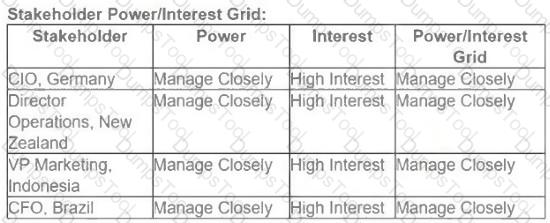
An agile development team is working on a digital transformation project and is facing challenges in obtaining consistent feedback from stakeholders who are dispersed around the world. The product owner is under pressure as this lack of engagement has led to prolonged decision-making cycles and has adversely affected the outcomes of sprints.
How should the team improve stakeholder engagement to help ensure timely feedback and better decision-making? (Refer to Stakeholder Power/Interest Grid)
A new stakeholder has recently joined a project. During a meeting with the scrum master, the new stakeholder tries to understand the status of the project and the remaining tasks for completion.
How should the scrum master inform the new stakeholder?
During an agile team retrospective, some junior team members discussed an approach that could improve the overall team performance. How should the agile practitioner handle the recommendation?
A team member has spent 5 days on a spike and the first set of experiments has not been successful. The issue is the development team member has determined a short-term rather than a long-term solution.
What should the project leader do?
During the review session, the product owner discovers that the user interface has a response time of 10 seconds. The non-functional requirements state that it should respond in less than two seconds. The team complains that this requirement was not communicated to them.
What should have been done to avoid this?
An agile team is having difficulties in obtaining the participation of a true user to be a part of their team. In the absence of a true user, the development manager steps in to act as a proxy for the user.
What can the agile team do to improve value delivery in the absence of a true user?
A new Scrum team is struggling with the various ceremonies of Scrum. Among other things, the product owner and stakeholders find the technical architecture and design presentations during sprint reviews less than informative.
What should the team do?
What should a Scrum Master do when one team member falls behind in their tasks?
A company is considering developing a new, complex application that will require a large initial investment However if successful the profit potential is high.
When preparing an analysis, what should be used to encourage stakeholders who are concerned about project failure to authorize the initial investment?
During a project review, the team discovers customer feedback that would add scope. The project leader is concerned that the team will be unable to incorporate this feedback and still meet the product launch date.
What should the project leader do?
A software development team is working in an environment in which increased competition, demanding customer expectations, and new technological developments pose significant challenges. How should the team plan improvements to their product?
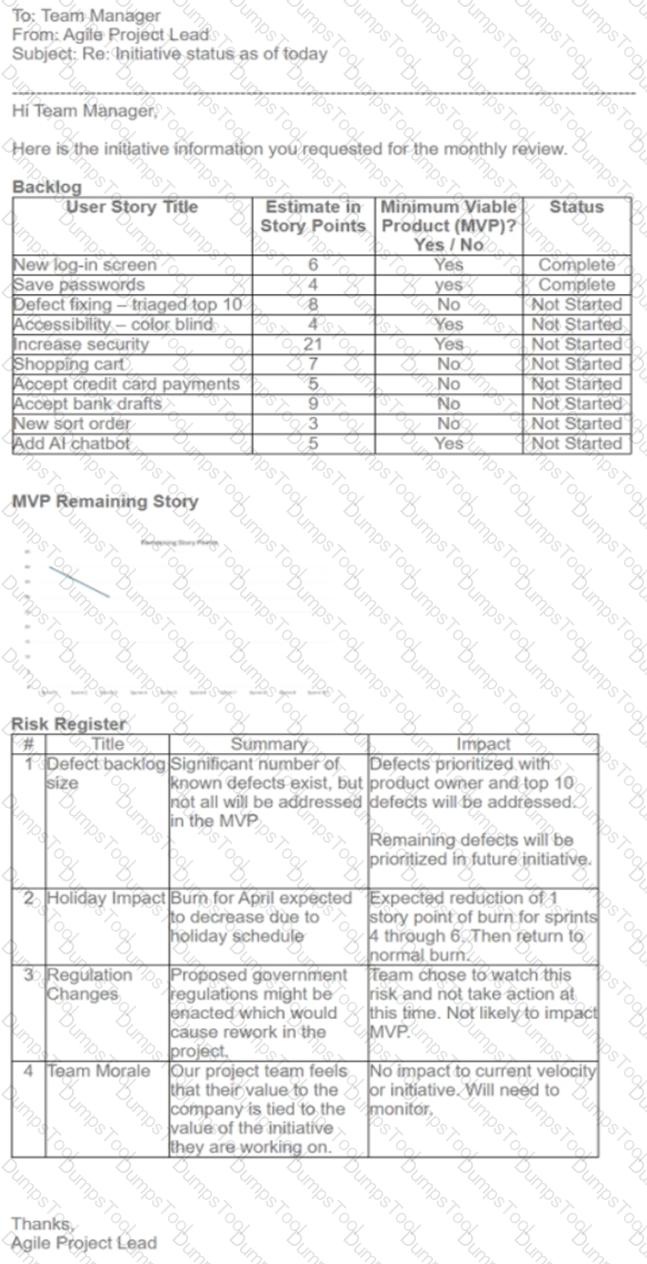
The manager of the team is responsible for delivering a specific initiative within the organization. They are preparing for the monthly project review meeting, where they will present the current state of this initiative. The agile project lead sends the manager the following email with the initiative's current status.
Which summaries are correct and will be presented during the monthly project review? (Refer to
the email and exhibits to the Team Manager)
A company president is concerned about the impact of a natural disaster on the company. How should management identify areas to apply its resources and mitigate potential impacts?
As user stories are developed, what should be done to record and update acceptance criteria?
A new agile team member notices that the team's current process involves excessive documentation. What should the new team member do?
A new project is under way and the team is using the Kanban method. One of the team members raised a specific issue related to a programming language that the team member faced in previous projects.
What should the project leader do to handle the issue?
A scrum master assumes a project that is essential to organizational growth. The project is expected to be in production for three years. What should the scrum master do first?
A team lead reviews processes and identifies bottlenecks that prevent the teams from quickly delivering minimum viable products (MVPs). Which responsibility falls within the context of servant leadership?
An agile team provides feedback that user stories include insufficient details to understand the requirements. What should the agile practitioner do?
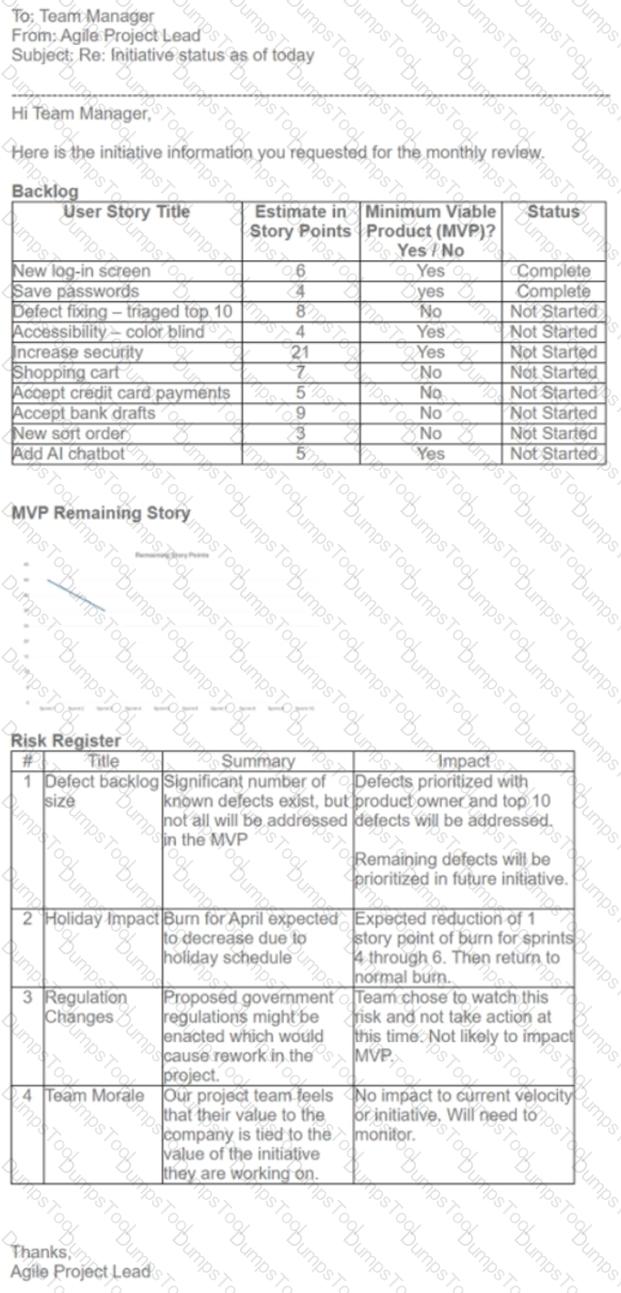
A project team's manager is responsible for delivering a specific initiative for the organization. They are preparing for a monthly meeting where the manager will present on the current state of this initiative. The agile project lead sends the manager the following email with the current initiative status (see Exhibit A).
At the end of which sprint will the minimum viable product (MVP) be completed?
A product owner worked with the customer to define the success criteria for the launch of a new product in the manufacturing industry. The project team responsible for development is seeking guidance on what to develop first.
Which two actions should the product owner take? (Choose two.)
Two team members are working together to deliver an asset management tool. The code delivered by team member A during this sprint is not aligning with the specifications written by team member B. Both team members do not seem to agree on the look and feel of some functionality.
What should the scrum master do in this situation?
The product owner of an agile project is frustrated because the team is unable to deliver as many features as expected. The product owner asks the team to reduce test-automation levels, since the quality assurance team will test the product at project completion. The product owner expects that more features will be delivered in each iteration using this approach.
What should the agile practitioner do?
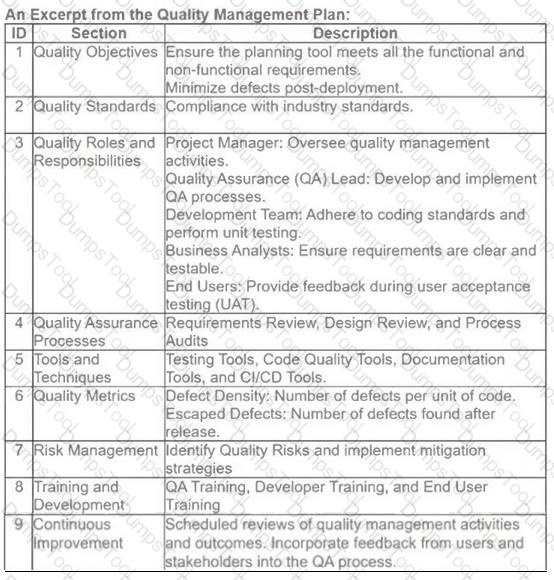
In a project to develop a supply-and-demand scenario planning tool, the team aims to streamline development and rapidly deliver features. Which approach best supports quick feature delivery while maintaining quality? (Refer to An Excerpt from the Quality Management Plan)
The agile practitioner has determined that two different team members are working on addressing the same major issue on the project. How should the agile practitioner address this?
A Kanban team is struggling to prioritize and determine which tasks to handle first according to value. What should the team do to improve this situation?
Trend analysis shows that velocity is significantly higher than predicted and the release can be completed one month ahead of schedule. The team recommends changing the end date to reflect this.
What should the agile practitioner do?
An agile coach advised a project manager to continuously improve their ability to support their team and remove any obstacles in the project's way. What role is the agile coach advising to the project manager to take on?
An agile team and a traditional development team are working together on a project. Each team exceeds expectations regarding deliverables: however, issues arise when the deliverables are integrated. What should the agile practitioner do?
Throughout the project, an agile practitioner notices that one team member is becoming an emergent leader. What should an agile practitioner do?
The scrum master for a large project must provide an estimate of what can be delivered in six months What should the scrum master do?
An agile team consisting of eight members is in their 11th iteration of a project. In the last iteration, the team was not able to complete every scope item it had committed to before the demonstration.
Which approach should the agile lead take?
An agile team consisting of eight members is in their 11th iteration of a project. In the last iteration, the team was not able to complete every scope item it had committed to before the demonstration.
Which approach should the agile lead take?
During an iteration review, the agile team asserts that a product is complete because development and review were finished. The product owner disagrees, since the product has not been tested.
What should the agile practitioner do?
A global organization is migrating its IT infrastructure from traditional, physical assets to cloud-based assets. Agile concepts are new to the organization because it currently uses a predictive approach.
What should an agile coach do to facilitate a culture change to an agile approach?
Unable to meet a sprint's committed velocity, an agile team approaches the agile coach to define the next sprint's velocity. What should the agile coach advise?
Business partners are attending a daily standup meeting for a project. The business partners are asking questions about the sprint backlog and delivery timing.
How should the project manager explain why this is not the forum to ask these questions?
A project's first iteration contains item A and its second iteration contains item B The first iteration is behind schedule, which will impact the second iteration. Since items A and B are similar, a team member suggests beginning the design of item B.
What should the agile practitioner do?
A scrum master has a team of six members. The team complains they are losing time because they are attending meetings for which they see no value.
What should the scrum master do?
Midway through a sprint, the scrum master identifies that reassigning a certain task could help the team meet its sprint goals What should the scrum master do next?
A team developing application software is working in pairs. A project manager notices that important information is sometimes not shared among team members, leading to delays in the development process.
What should the project manager do to improve team performance and eliminate any communication impediments?
A For new pairs of developers based on the years of expertise and project management Knowledge
B. Use task boards so the team can keep track of the work done and future implementation planning.
C. Schedule in-person meetings at the end of each iteration, allowing team members to share knowledge and experience.
D. Seek expert judgment and a new collaboration model that will strengthen team cohesiveness.
The agile team disagrees with the business stakeholders on completing some epics What could help eliminate misunderstandings?
On an agile project, some of the development team is struggling to understand how the tasks and user stones fit into the overall product. How should this be addressed?
During a backlog refinement meeting, a senior team member raises a concern about an epic sizing that requires the use of a new interface for a vendor product. The product owner acknowledges this as a risk. What should the product owner do now?
One of the senior stakeholders on a project did not want to be engaged on a daily basis. During the iteration, the team encounters complexities but are convinced these issues can be resolved in time for the demo.
What should the agile practitioner do?
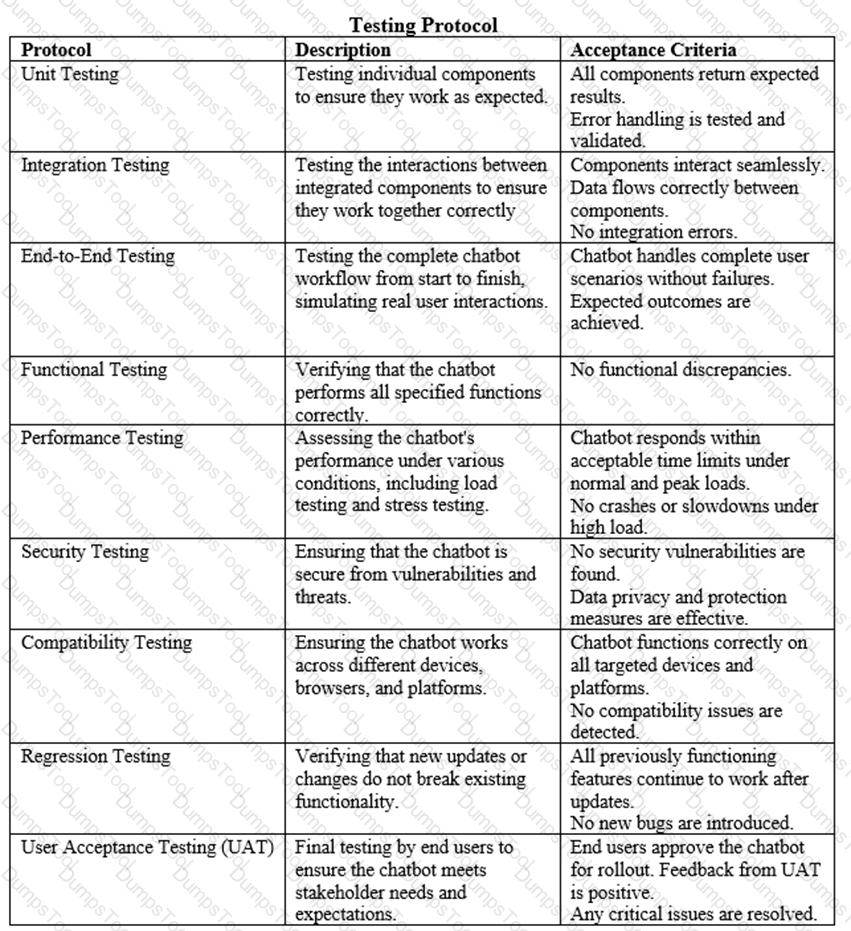
A scrum master is overseeing the launch of a chatbot for the service desk. Complaints come up post-release about edge case responses to queries. After analyzing the issues, the business decision was made to take the chatbot offline, resulting in workflow disruptions and risking the reputation.
How could this situation have been avoided? (Refer to Testing Protocol Table)
A company is planning to launch a new service to improve the customer checkout experience. What should the project manager do to meet the objective of reducing time to market to gain a competitive advantage in the industry?
The initial roadmap and release dates for an agile project were set based on data from similar projects and some expert opinions. Halfway through the project, however, the team’s estimates are different. Based on the team’s velocity, two more iterations were necessary to accomplish the initial scope.
How should the agile lead explain the difference to the project sponsor?
An agile team is continuously interrupted by stakeholders wanting to ask product backlog questions. Distractions can have a negative impact on value delivery and quality.
Who is responsible for protecting against distractions?
A technical problem arises that will likely impact the stories planned for delivery in the current sprint What should the scrum master do?
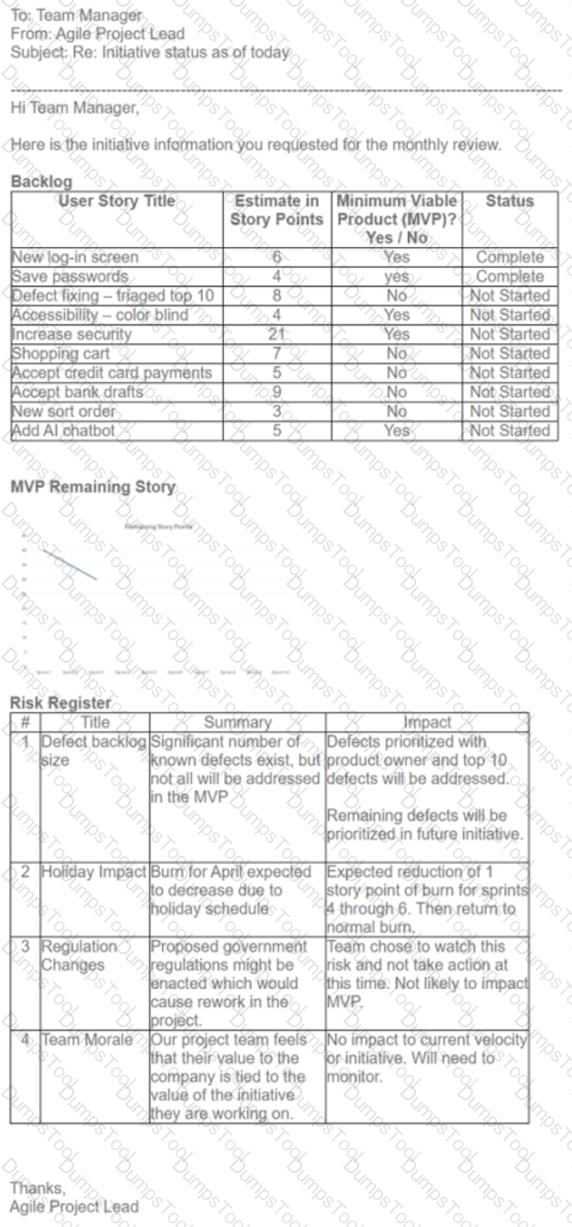
A project team's manager is responsible for delivering a specific initiative for the organization. They are preparing for a monthly meeting where the manager will present on the current state of this initiative. The agile project lead sends the manager the following email with the current initiative status (see Exhibit A).
How many sprints will be needed to complete the entire backlog?
The first project vision statement meeting for a newly formed team did not achieve its outcome. Lack of participation combined with conflicting views of those who participated led to disagreement on how to proceed.
How can the team improve their collaboration?
An organization is shifting to an agile delivery methodology. An agile project manager has been assigned to the transformation project.
What should the agile project manager do to ensure a high level of adoption?
After completing the release plan, the team realizes that the project is very likely to have a negative ROI What should the team do?
An agile team is under pressure to deliver an application. The product owner anticipates many change requests from customers once the product is released.
What should the agile team do?
What should a product owner do when a new stakeholder is complaining that they are not receiving the relevant financial data regarding the project.
During iteration planning, it was determined that an epic should be decomposed What was the determining factor?
As part of the organizational change, all project teams within the digital channel’s portfolio have been directed to move from 3-week iterations to 2-week iterations. The development team is frustrated as they think there will not be enough time to test. The product owner does not like this change as it will increase the number of ceremonies.
Which two actions should the scrum master take? (Choose two.)
A new agile project manager accepts an assignment to manage a well-established team Many team members have worked together on this product for several years During a meeting, the project manager notices that team members offer little vocal interaction, yet all required tasks are completed on time
What type of behavior does this describe?
A product owner adds user stories to the backlog on a daily basis. The stories are vague requests, and the product owner expects the details to be clarified once the team works on the prioritization list.
How should the team members address this challenge so that the prioritization meeting does not become a brainstorming session?
A team member starts discussing a project roadblock during a daily coordination meeting. The team discusses details of the impediment, which takes up most of the meeting time.
What should the agile facilitator do?
A development team and product owner disagree on a user story in the product backlog What should the agile practitioner do?
Senior management is frustrated at the lack of a detailed implementation plan that shows exactly when the project will end and when all requirements will be met. The team has been using a rolling wave planning approach so far on the project.
How should the agile practitioner explain to senior management the benefits of this approach?
During a review close to a product release, the customer spotted several features that will need to be changed. What caused this to happen?
An experienced product owner presents the epics and corresponding stones during a release planning session with the established team. The executive sponsor asks the team when the features will be delivered.
What should the agile team do?
A development team is calculating the number of story points they have completed at the end of an iteration. Although quality assurance (QA) passed and successfully demonstrated one feature, it is not being included in the release package.
Should the team add the feature's story points to their burndown chart?
A project sponsor suggested a team forgo in-person demonstration meetings and just send the product owner a link to try out the latest increment of working software. The sponsor says this will give the team more time to deliver value.
How should the agile coach explain the importance of an in-person demonstration meeting with the sponsor?
A key stakeholder cannot attend the project vision statement development workshop. The stakeholder has emailed their requirements to the agile team lead, and believes that the vision statement is not critical.
How should the agile team lead respond?
During a daily stand up meeting, a developer expresses concerns that the selected technology limits the number of concurrent users. What should the agile team lead do?
A Scrum team is visualizing the blockers that arise when they work on their activities on the kanban board. The team decided to analyze why the blockers occur so they can take action to minimize their occurrence and reduce lead times.
Which practices should the team use?
During a project's last iteration, an agile team struggled with a feature's delivery due to the lack of a required skill. The project has already incurred a five-day delay. A further delay of at least 10 days is anticipated.
What should the agile project leader have done to avoid this situation?
As a team completes their 21st sprint, new information reveals that a number of significant system integrations must be made to ensure the project scope is met. How should the project management plan be adjusted?
A member of a cross-functional project team is not able to attend regular status meetings and provide progress updates, which is impacting the productivity of the entire team. What should the product owner do to improve productivity?
A newly formed, colocated team is participating in daily standups, but is otherwise working largely as individual contributors. This has resulted in misalignment of activities. Planned velocity is being met.
What should the agile practitioner do?
An agile lead is working on a project to build a new product that will bring substantial business value to a company. Company executives want to present the first release at an important industry fair the following month. The agile lead started the project the previous month, and the team planned the release to take 8 iterations. For the past 4 iterations, work has been performed as planned and on time. In the current iteration, however, one team member will be out for the remainder of the project. Without this team member, velocity would drop 30%.
What should the agile lead do to ensure the release will be on time for the fair?
The product owner is present at the sprint review meeting and states that an estimation for the end of the project must be shared with the company’s steering committee. The scrum master declares that the team reached an average velocity of 40 story points per sprint, considering a biweekly iteration. The team members predict that there are 240 story points remaining.
What is the estimated project conclusion?
An agile coach is guiding a team across multiple locations. They need a united communication approach that involves task-oriented communications and discussion boards with effectiveness.
Which method of communication would be most effective?
A mobile application project is halfway through development. The team reaches a stabilized velocity after 8 iterations. The sprint duration is two weeks and requirements assigned by the product owner are not changing frequently.
What is the estimated time remaining for the project?
During sprints, the development team members are frequently invited to various meetings to provide technical opinions, consuming the team's working time and causing compliance issues. Which action should the scrum master take to address this situation?
A product owner wants to create a release plan given the team is working in a chaotic environment. They want to set expectations about what is likely to be developed and in what timeframe for some of the stakeholders.
What should the product owner include in the release plan to achieve this?
During a mature agile team's planning meeting, a team member proposes a new framework that would considerably reduce implementation time. However, the team lacks the confidence to try the new framework.
To help the team gain confidence, what should the agile practitioner suggest?
An agile project team has team members with varying technical skills. Due to recent events that adversely impacted customer satisfaction, management mandated that Kaizen should be given more focus to ensure the quality in product delivery.
Kaizen is a prime concept of which agile practices?
A team using Kanban identifies that their cycle time has significant variation After brainstorming the team determines that the root cause is the stones' varying sizes and risks.
What should the team do?
During a review session, an agile team presented done requirements to a group of stakeholders Stakeholder feedback indicated that the done requirements failed to meet the most pressing needs and provide value.
What should the team have done to prevent this?
A project is to be started with a team of nine existing and nine new members. The scrum master feels that the team is too large and wants to break it into three teams. The scrum master sets aconstraint that each team have an equal number of existing team members for knowledge sharing and experience.
What should the scrum master do to accomplish this?
An agile team is working on a new product and is behind with their deliverables for the quarterly release. The team discovers new issues during each iteration. They start working on the critical issues and sometimes forget to update the backlog. This leads to confusion, delays, and occasional rework.
How should the agile practitioner improve the team’s productivity?
A project manager is managing a large complex project with cross-functional teams using an adaptive approach. Frequent communication among the team leads of these cross-functional teams is crucial for the project to stay on track and deliver value according to the project plan.
Which agile communication practice should the project manager implement to ensure the cross-functional teams interact frequently?
During a sprint demo, a business representative identifies missing requirements. The agile practitioner realizes that all key stakeholders were not included during requirements detailing.
What should the agile practitioner have done to avoid the situation?
A high-profile project team is struggling to meet planned velocity. During a retrospective, the team agreed that their lack of experience in the technology resulted in an excess of rework.
What should be done to resolve this challenge?
During a retrospective, the team agrees that they have limited competence in using a newly introduced tool. What should the team do?
During a coaching session, an agile project manager discussed embracing communication to keep all stakeholders aligned. The agile project manager recently had a discussion with their team and decided to display a product roadmap.
What is the agile project manager trying to show?
What should an agile practitioner do to ensure that the end product meets business requirements?
A user interface (UI) developer has features for channels ready for review. During the team review, the architect is disappointed that Splunk software has not been implemented for better server and client logs. The architect insists on the implementation of Splunk software, which will impact the release date.
Which one of the following is the ideal option for the team to resolve this conflict?
During an executive review, a scrum master uses a burndown chart to demonstrate team deliverables through time. The scrum master declared that velocity increased from 27 to 35 over the last 3 sprints, but one of the executives asks to clarify the importance of these metrics.
How should the scrum master respond?
An agile practitioner becomes a Scrum Master on an established Scrum team. After introductions, what should the agile practitioner do?
An agile learn has only one database administrator with the necessary knowledge of database-related tasks. The project manager identifies the risk that if this person leaves, team velocity will significantly decrease.
What should the agile coach do?
A project team has a senior subject matter expert (SME) who is comfortable with data integration. The SME is not inclined to perform regression testing because the SME feels that performing regression testing is more of a junior duty.
What should the scrum master do?
An agile practitioner wants to ensure that stakeholders have current information about a project's progress What should the agile practitioner do?
A large, corporate organization is forced to hire new team members in a geographically remote location from the current team. The manager of the department is concerned about the team not being colocated.
What behavior would indicate the team is not working well together?
During sprint retrospectives, some team members are very vocal and tend to dominate the conversation, while others are more reserved and less likely to participate. What should the scrum master do?
A globally distributed project team is using email and phone calls as the only way to share information. Delays in resolving issues often occur due to misinterpreted communications, leading to a lower team velocity.
What steps should the project leader take to improve knowledge sharing?
An agile leader has been assigned to a project that involves significant technical complexity. What should the agile leader do to set the project up for success?
A legal department representative contacts the scrum master because, while the project's budget has been maintained, it has exceeded its original contracted time and scope What should the scrum master do?
A servant leader is leading a high-visibility project to deliver a new product. The servant leader has been able to build a cross-functional team and create a team space where the team is collocated. The servant leader started receiving frequent visits from a company director, who continually asks a specific team member questions about project progress. The conversations are distracting the team from their goal.
What should the servant leader do?
A product owner new to the role is very enthusiastic about an agile project with an energetic team What should be done first to ensure successful delivery of the product?
Part way through a project, several team members are in conflict over whether or not a deliverable has been properly completed. How should the agile leader reduce this conflict?
An agile project leader notices that the team's velocity has decreased in examining data provided by team members, the project leader discovers that one team member has been slow to enter story statuses
What can happen as a result?
A product owner obtains customer confirmation on product requirements and provides them to the team. After explaining the user stories, the product owner receives agreement for acceptance from the team. What should the team do next?
Management decides to set up a new project to exploit an emergent market opportunity. Management suggests using an agile approach that is currently working for another project.
What should the agile leader do next?
Management decides to set up a new project to exploit an emergent market opportunity. Management suggests using an agile approach that is currently working for another project.
What should the agile leader do next?
A key stakeholder feels they do not understand the project at a comprehensive level. What should the agile practitioner do?
Members of an agile team are complaining that user stories are too large, taking multiple sprints to complete them. They say this way of working is becoming difficult to handle and it has been challenging to map relationships between stories. This situation is affecting the value delivery for the product owner.
What should the scrum master do to handle this situation?
The productivity of an agile team has fallen significantly in the last sprint. The team members have not mentioned any impediments but seem to be fatigued.
What should the agile practitioner do?
Midway through a sprint, a team member discovers that the product design fails to adhere to the organization's enterprise architecture standards. Since this required escalation to the architecture team for further analysis and resolution, the team was unable to deliver its sprint goal and the sprint was cancelled.
What should the team have done to avoid this?
Some members of an agile project team work remotely, so it is difficult to have regular face-to-face backlog grooming sessions. How should the agile practitioner ensure that the team is able to reduce miscommunication and rework in this environment?
What is the first thing an agile development team should do when planning an iteration?
How should the project manager introduce the team, communicate the importance of the team charter, and help develop a high-performing team?
A project charter has been completed and is ready for approval. The project's goal and approach have been clearly determined and a list of generalized specialists has been set.
How should the project manager introduce the team, communicate the importance of the team charter, and help develop a high-performing team?
A graphic designer on an agile team does not attend most meetings. When asked the reason for not attending, the designer told the agile practitioner that the scrum master could represent them in meetings if needed. The team is frustrated and does not agree with this approach.
Which conflict resolution method would work best in this scenario?
One of the main stakeholders of a project is new to Scrum. The stakeholder asks what to expect in the sprint retrospective.
How should the product owner respond?
An agile lead is experienced with predictive and agile approaches. The agile lead was recently invited by human resources (HR) to be part of a learning team. During roundtable discussions with the project management team, the agile lead states: "I foster a safe environment for disagreement so my team feels empowered to move forward without obstacles."
What is the agile lead attempting to highlight?
At the retrospective, the burndown chart shows that the project is slightly behind schedule. The project team identifies an inexperienced software engineer as the source of reduced velocity. How should the project team address this issue?
A software project is being implemented by a small, colocated team. What should the project manager do to keep the team focused and engaged with the high level of requirements?
A new project has been approved and is critical for an organization. The project sponsor has a limited budget, and the deadline to have all requirements meet the definition of done (DoD) is short.
Which approach should the agile practitioner take to facilitate the project's success?
The agile lead is told by executive leadership that the team needs to work faster because the release date has been moved up three months. The agile lead communicates the updated timeline to the team. One of the junior team members objects and feels the timeline is unrealistic.
What should the junior team member do?
A backlog for a project has been prioritized and a sprint has begun. A security issue has been revealed that needs to be addressed or large security vulnerabilities will be exposed.
How should the project manager proceed?
During agile training, an aspiring scrum master with experience in predictive projects asks about the differences between the Kanban approach and the agile approach.
How should the agile trainer respond?
A product owner feels that the last sprint failed to sufficiently deliver what was valuable to their organization's overall project goals. What should the scrum master mention at the next retrospective?